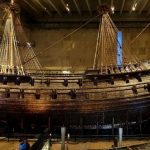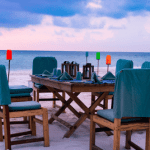 History
History  History
History  Creepy
Creepy 10 More Representations of Death from Myth, Legend, and Folktale
 Technology
Technology 10 Scientific Breakthroughs of 2025 That’ll Change Everything
 Our World
Our World 10 Ways Icelandic Culture Makes Other Countries Look Boring
 Misconceptions
Misconceptions 10 Common Misconceptions About the Victorian Era
 Mysteries
Mysteries 10 Strange Unexplained Mysteries of 2025
 Miscellaneous
Miscellaneous 10 of History’s Most Bell-Ringing Finishing Moves
 History
History 10 Great Escapes That Ended Right Back in Captivity
 Weird Stuff
Weird Stuff 10 Fascinating Things You Might Not Know About Spiders
 Food
Food 10 Everyday Foods You Didn’t Know Were Invented by the U.S. Military
 History
History 10 Most Influential Protests in Modern History
 Creepy
Creepy 10 More Representations of Death from Myth, Legend, and Folktale
 Technology
Technology 10 Scientific Breakthroughs of 2025 That’ll Change Everything
Who's Behind Listverse?

Jamie Frater
Head Editor
Jamie founded Listverse due to an insatiable desire to share fascinating, obscure, and bizarre facts. He has been a guest speaker on numerous national radio and television stations and is a five time published author.
More About Us Our World
Our World 10 Ways Icelandic Culture Makes Other Countries Look Boring
 Misconceptions
Misconceptions 10 Common Misconceptions About the Victorian Era
 Mysteries
Mysteries 10 Strange Unexplained Mysteries of 2025
 Miscellaneous
Miscellaneous 10 of History’s Most Bell-Ringing Finishing Moves
 History
History 10 Great Escapes That Ended Right Back in Captivity
 Weird Stuff
Weird Stuff 10 Fascinating Things You Might Not Know About Spiders
 Food
Food 10 Everyday Foods You Didn’t Know Were Invented by the U.S. Military
10 Distress Calls from Sinking Ships That Are Unforgettable
Few experiences in life are as terrifying as being on board a ship as it is sinking. Sheer panic as alarms blare, everything shifts, and the water keeps rising, leaving passengers and crew members with nothing to do but pray that help comes in time so they can see their loved ones again. Tragic situations like these bring out the best or the worst in people—and everything in between. Telegraphs, radio transmissions, audio recordings, and even cell phones have offered a glimpse into the final minutes of these tragedies. Witness the harrowing last moments on board ten sinking ships through the distress calls from their crew.
Related: Top 10 People Who Mysteriously Vanished From Cruise Ships
10 The RMS Titanic
Let’s start with the most famous ship that ever existed: the RMS Titanic. As depicted in many books, TV shows, and the 1997 movie, the Titanic struck an iceberg during its maiden voyage in 1912. Warnings about ice in the area led to speculations that Jack Philips, the chief telegraphist, was distracted, forgot, or never got around to sharing them with the captain.
Just before midnight on April 14, Philips and his assistant, Harold Bride, sent distress signals that provided a detailed timeline. The Carpathia, Frankfurt, and Olympic, the Titanic’s sister ship, changed course to help. Philips stayed at his post until the very end. Reportedly, there was “never a tremor” in the Morse he tapped out.
Final telegraphs from the Titanic:
Titanic to the Carpathia: “Come at once. We have struck a berg. It’s a CQD, old man.”
Titanic to the Frankfurt: “We have struck an iceberg and sinking by the head.”
Titanic: “We are putting passengers off in small boats. Women and children in boats. Cannot last much longer. Losing power.”
Titanic: “This is Titanic. CQD. Engine room flooded.”
Olympic: “Am lighting up all boilers as fast as we can.”
The last telegraph, sent a few minutes before the ship sank:
“Come quick. Engine room nearly full.”
Only 712 of the 2,208 people on board the Titanic survived.[1]
9 The SS Princess Sophia
In one of the worst maritime disasters in Alaskan history, the SS Princess Sophia struck the Vanderbilt Reef on October 24, 1918, while sailing from Skagway to Juneau. When a snowstorm hit, Captain Locke neglected to slow the ship to the recommended speed because he wanted to stay on schedule. The Princess Sophia veered off course into the reef, trapping it in place.
The weather conditions and high seas made rescue efforts impossible. Locke waited for the ship to free itself for nearly 40 hours, but the storm worsened and tore it to pieces. Unfortunately, 2,900 barrels of oil spilled from the wreck.
On October 25 at 5:20 pm, wireless operator David Robinson sent: “For God’s sake, hurry, the water is coming into my room.”
A lighthouse tender: “We are coming. Save your batteries.”
Robinson: “Alright, I will. You talk to me, so I know you are coming.”
The only survivor was a dog.[2]
8 The Thresher
The USS Thresher was the Navy’s newest nuclear-powered submarine about 60 years ago. On April 10, 1963, communications were suddenly lost with the Thresher. The submarine sank just 24 hours later, crushed by ocean pressure after dropping to 2,400 feet (731.5 meters), 400 feet (122 meters) below what the hull could withstand.
The cause was a ruptured pipe, explained retired Vice Adm. Ron Thunman, who commanded the Thresher’s sister sub, the Plunger. The “spray grounded the electrical systems… It caused the reactor to [shut down].”
In a declassified log from a submarine called the Seawolf, one of the ships that searched the area, the crew heard various pings and sounds that they attributed to the missing Thresher.
The Seawolf broadcast:
“We hear your underwater telephone. If you will send 5 dashes we will have positive identification—send 5 dashes.”
There was no report of 5 dashes recorded. Halfway through its search, the crew reported a “total of 37 pings heard counted.” The Seawolf also described hearing a “very weak voice” over their underwater recorders and metal-on-metal banging on sonar.
Many claim it was false hope. Chris Drew, author and former military journalist, responded: “There’s a lot of sounds in the ocean.”
The 129 crew members were never found.[3]
7 The El Faro
The El Faro, an American cargo ship, was fully equipped with state-of-the-art satellite communications and advanced weather forecasting software. Unfortunately, the weather data communications system was faulty, and, as a result, the captain made decisions based on information that was six hours out of date. On October 1, 2015, the El Faro sailed straight into the eye of Hurricane Joaquin and sank in the middle of the Bermuda Triangle.
An excerpt from an audio recording on the bridge of the ship:
8:21 pm
Third Mate: “Maybe I’m just being a Chicken Little. I don’t know.”
11:05 pm
Third Mate to Captain: “[the hurricane with 100 mph winds] advancing toward our trackline—and, uhhhh, puts us real close to it.’”
12:43 am
Second Mate: “Every time we come further south, the storm keeps trying to follow us.”
1:15 am
Second Mate: “Oh, my God.”
6:54 am
Captain Davidson: “miserable right now” and “We’re gonna stay with the ship. We are in dire straits right now.”
7:01 am
Capt. Davidson calls the ship owner:
“This is a marine emergency…we had a hull breach, a scuttle blew open during a storm. We have water down in three hold. We have a heavy list. We’ve lost the main propulsion unit. The engineers can not get it going.”
“No one’s panicking.”
7:17 am: U.S. Coast Guard receives an electronic message from El Faro.
7:39 am: Recording ends with Capt Davidson still onboard the ship.
None of the 33 crew members survived.[4]
6 The Gulf Livestock 1
The Gulf Livestock 1 left Napier, New Zealand, on August 14, 2020, carrying 5,867 cattle and 43 crew members. The ship was en route to the port of Jingtan in Tangshan in China, a 17-day journey. A distress call was sent near Amami Oshima island in southwestern Japan when faced with 78mph (125.5 km/h) winds from Typhoon Maysak.
The Gulf Livestock 1 was struck with a wave, causing the engine to fail and the ship to capsize. Authorities launched a review into live trade the previous year after thousands of exported animals were lost. “These cows should never have been at sea,” said animal rights organization SAFE.
WhatsApp messages sent by senior stockman William Mainprize (WM) and his sister Sarah (SM):
SM: “Hey Bro can you let me know when you’re through it”
SM: “It’s scaring me”
WM: “Will do Sar! Should be fine – we’re a big boat.”
There were only two survivors.[5]
5 The SS Edmund Fitzgerald
Christened on June 8, 1958, the SS Edmund Fitzgerald spent the next 17 years breaking records for the largest loads of freight carried on the Great Lakes. On November 9, 1975, the Fitzgerald departed from Superior, Wisconsin, heading to Zug Island on the Detroit River, carrying 26,000 tons of taconite pellets.
The National Weather Service issued gale warnings by the afternoon, and the next day saw winds of up to 60 mph (96.5 km/h) and 10-foot (3-meter) high waves. Following about 15 miles (24 kilometers) behind was another ship, the Arthur M. Anderson, who kept in contact with the Fitzgerald through the upcoming storm.
Radio transmission between the saltwater vessel Avafors and the Edmund Fitzgerald:
Avafors: “The wind is really howling down here. What are the conditions where you are?”
Fitzgerald: (Indiscernable shouts heard by the Avafors.) “DON’T LET NOBODY ON DECK!”
Avafors: “What’s that, Fitzgerald? Unclear. Over.”
Fitzgerald: “I have a bad list, lost both radars. And am taking heavy seas over the deck. One of the worst seas I’ve ever been in.”
Avafors: “If I’m correct, you have two radars.”
Fitzgerald: “They’re both gone.”
A radio transmission between the Anderson and the Fitzgerald:
Anderson: “Fitzgerald, how are you making out with your problem?”
Fitzgerald: “We are holding our own.”
Anderson: “Okay, fine. I’ll be talking to you later.”
All 29 men on board were lost.[6]
4 The Pacific
The Pacific, an American paddle-wheel steamship, left Liverpool for New York on January 23, 1856, with 45 passengers and 141 crew on board. The ship, commanded by Captain Asa Eldridge, never reached its destination. The fate of the Pacific, its passengers, and its crew was unknown until a message in a bottle washed up on the shore of the Scottish Hebridean island of Uist in 1861. Rather than explain what happened to the ship, however, the message only added to the mystery as officials scrambled to connect the author to the lost ship.
The message, handwritten on the leaflet of a pocketbook, read:
“On board the Pacific, from L’pool to N. York. Ship going down. (Great) confusion on board. Icebergs around us on every side. I know I cannot escape. I write the cause of our loss, that friends may not live in suspense. The finder of this will please get it published.
Wm. Graham”
There are assumed to be no survivors.[7]
3 The Andrea Gail
The Andrea Gail, a small fishing trawler with a close-knit crew of six, encountered a deadly storm in the fall of 1991. The storm, eventually dubbed “the perfect storm,” which inspired the movie with the same name, headed up the coast from Florida to Nova Scotia.
The Andrea Gail sailed out of Gloucester for a month-long fishing trip off the coast of Newfoundland, unaware of the catastrophic storm approaching. The storm produced a fatal 100-foot (30.5-meter) wave and devastated both land and sea. Based on the Andrea Gail’s last known position, the ship most likely went down in the same area as the Titanic.
The last radio communication was between Captain Billy Tyne and the Coast Guard:
Tyne: “She’s coming on, boys, and she’s coming on strong!”
There were no survivors.[8]
2 The Costa Concordia
In January 2012, the Costa Concordia set off on a seven-day Italian cruise from Civitavecchia to Savona carrying 4,229 people. When Captain Schettino altered the path to sail closer to the island of Giglio, the ship struck a reef known as the Scole Rocks at 9:45 pm. The evacuation was chaotic… and questionable. The first person to notify rescue officials about the ship was a witness on shore. The captain reportedly tried to downplay and cover up his actions, not telling officials what happened for more than 20 minutes.
A recorded phone call between Captain Schettino and the crisis coordinator:
Schettino: “I have made a mess and practically the whole ship is flooding…What should I say to the media?…To the port authorities, I have said that we had… a blackout.”
Somehow, Schettino made it to the lifeboat before everybody else evacuated the ship. A coast guard member told him to: “Get back on board, damn it!”
Sadly, 32 lives were lost. Many others were seriously injured. Captain Schettino was tried and sentenced to 16 years in prison.[9]
1 The Oryong 501
The Oryong 501, a trawler, was fishing for pollock in the Bering Sea off the coast of Russia when it started to take on water. The captain, Kim Gye-hwan, and his crew pumped out more than half of the water when he made radio contact with Lee Yang-woo, captain of the Oyang, a tuna fishing vessel near the same area.
Gye-hwan had worked as Yang-woo’s first mate from 2004 to 2007. They remained close friends for 10 years. He told Yang-woo it looked like everything was going to be okay. But only 10 minutes later, the Oryong 501 was tilting 45 degrees to the left. He sent his friend an emergency message saying he’d received orders to evacuate the ship.
Twenty minutes later, captain Gye-hwan contacted his friend one last time:
Kim: “Yang-woo, I wanted to say goodbye before the end.”
Lee: “Don’t say that! Get all of the crew off the ship safely, and then make sure that you make it out alive as well.”
Kim: “All the lights inside the ship are off. After what I’ve done to the crew, how could I let myself survive?”
Lee: “Don’t say that. Evacuate the crew and get off the ship. All sorts of things happen to people, you know. It doesn’t need to be a big deal. Gye-hwan, get the whole crew off alive, and we’ll get a drink in Busan.”
Seven of the crew members were rescued, 12 were confirmed dead, and 41 are still missing.[10]






